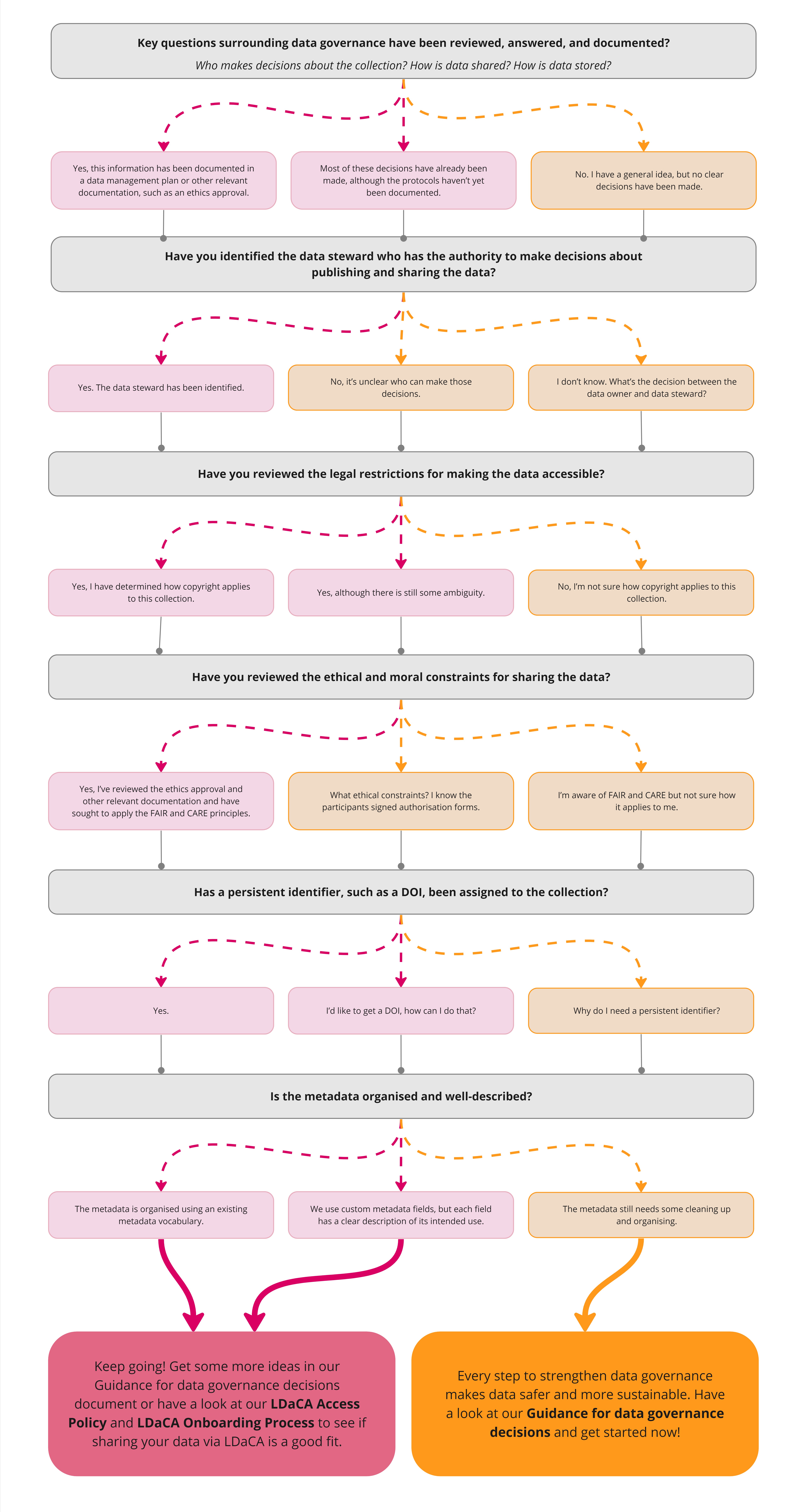Purpose
Onboarding Process
- 1. Initiating contact between LDaCA and Data Stewards
- 2. Work Plan
- 3. Determining appropriate governance and access conditions
- 4. Preparing data for cataloguing in LDaCA
- 5. Ongoing engagement
Purpose
This document outlines the standards and processes that support the onboarding of language collections to LDaCA. A successful onboarding will result in the collection being catalogued with LDaCA and made available in accordance with the specified access conditions. To determine if you are ready to onboard a collection, check this data management and governance capacity flowchart.

Image Source: LDaCA
Onboarding Process
The LDaCA onboarding process is carried out collaboratively between LDaCA and the Data Steward. There are five broad steps to be followed; while the order of these steps is flexible, each step should be appropriately covered.
- Initiating contact between LDaCA and Data Stewards.
- Establishing a Work Plan.
- Determining the data governance and access conditions appropriate for this collection, and applying that in LDaCA.
- Preparing data for onboarding to LDaCA.
- Facilitating ongoing engagement.
These five steps are covered in detail below, along with the responsibilities of LDaCA and the Data Steward for each step, and associated resources.
1. Initiating contact between LDaCA and Data Stewards
Data Stewards wishing to onboard data to LDaCA may approach LDaCA about this, and LDaCA will also seek to identify appropriate collections for onboarding.
LDaCA will gather relevant publicly available information, and record that information in a collection onboarding database. This includes information about the current location, significance and description of the collection; size, format and data structure; existing metadata; persistent identifiers (if any) and contact person.
Contact between LDaCA and the Data Steward is initiated with the aim of identifying the appropriate Data Steward, establishing a collaborative relationship, providing information about LDaCA, and discussing shared goals for the onboarding of the collection to LDaCA.
LDaCA will:
- Respond to requests to onboard data to LDaCA and/or research data collections and approach contact people about onboarding data to LDaCA.
- Provide information about LDaCA.
- Confirm the Data Steward.
- Help to determine if the data collection is ready for onboarding.
- Discuss needs and goals for onboarding to LDaCA.
Additional resources relevant to this step:
2. Work Plan
Once communication between LDaCA and the Data Steward is in place, a Work Plan is prepared in order to establish the terms according to which the data will be onboarded to LDaCA, including the goals and responsibilities of each party, and the steps and timeline for carrying out the onboarding process.
At this stage, it is important to share key information and resources about the LDaCA project and manage expectations.
LDaCA will:
- Provide the Work Plan template for onboarding.
- Collaborate with the Data Steward on the development of the Work Plan.
- Provide further information about LDaCA, its services and limitations.
Data Steward will:
- Confirm their role as the Data Steward.
- Collaborate with LDaCA on the development of the Work Plan.
Additional resources relevant to this step:
3. Determining appropriate governance and access conditions
LDaCA will collaborate with the Data Steward to (i) understand legal, ethical and moral considerations around data accessibility, and (ii) map the access conditions and how these should be implemented.
At this stage, the Data Steward must prepare a data access license that clearly outlines the conditions for data access, sharing and reuse. LDaCA makes available varying levels of access, from open access to restricted access. A persistent identifier for the collection must also be provided to support sustainable data management practices.
LDaCA will:
- Provide guidance and support with regards to data governance, persistent identifiers, determining access conditions and licensing.
Data Steward will:
- Review the legal, ethical and moral conditions for providing access to the collection, including the identification of existing data access licenses if applicable.
- Ensure that any agreed-on restrictions with funding bodies and participants are strictly adhered to.
- Identify the copyright holder and confirm the copyright status.
- Provide or develop data access licenses that outline the specific conditions for access to the collection, including citation information.
- Provide a persistent identifier for the collection (obtaining a DOI if necessary).
Additional resources relevant to this step:
4. Preparing data for cataloguing in LDaCA
LDaCA coordinates with the Data Steward to apply standards to the collection to support its long-term sustainability. The standards applied allow the data to be packaged in RO-Crates, the metadata to be mapped onto LDaCA’s metadata schema, and additional metadata to be added where possible/required.
LDaCA will:
- Prepare the data for packaging as RO-Crates.
- Support the metadata mapping process.
Data Steward will:
- Provide a copy of the collection data.
- Support the RO-Crate packaging by applying standards to the data and reviewing the packaged data.
- Provide metadata and collaborate with metadata mapping.
Additional resources relevant to this step:
5. Ongoing engagement
Finally, we implement ongoing engagement by outlining shared responsibilities and processes in order to ensure that access requests, system updates and user feedback are responded to appropriately by LDaCA and Data Stewards. This is key for collections that require access approval on a case-by-case basis and for collections that may introduce data updates, such as additional data, transcription, or annotation, edits to existing data, transcription, or annotation etc.
LDaCA will:
- Incorporate updates to the data collection provided by the Data Steward.
- Make the Data Steward aware of any takedown requests.
- Update the Work Plan as relevant, with responsibilities for ongoing maintenance of the collection in LDaCA.
Data Steward will:
- Make LDaCA aware of any updates to the data collection they wish to incorporate, and work with LDaCA to incorporate them.
- Review any takedown requests, make a decision about how to address them, and inform LDaCA of that decision.
- Update the Work Plan as relevant, with responsibilities for ongoing maintenance of the collection in LDaCA.
